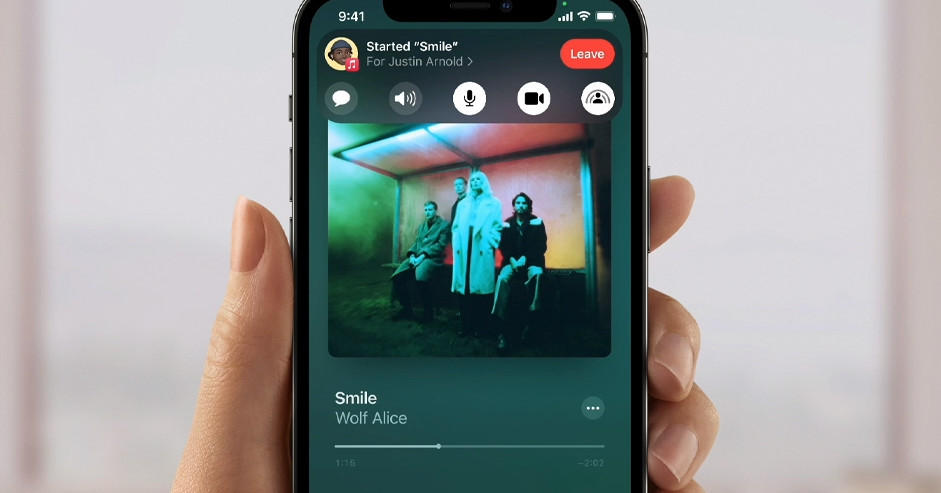Apple is bringing one of streaming’s trendiest features to iPhone users with the debut of SharePlay in iOS 15 later this year, allowing FaceTime users to stream music, online videos, and movies together with friends. The move positions FaceTime to compete more directly with platforms like Facebook Messenger, Instagram, and Houseparty, which all offer ways to video chat while watching things as a group. It offers Apple a chance to hook a new generation of users on FaceTime — but the service is still missing some key integrations to make that happen, particularly for the teens most likely to use it.
SharePlay, announced earlier this week and likely arriving in the fall, will allow FaceTime users to share and stream media in real time from an iPhone, iPad, Mac, or Apple TV. It’s a neat tool for the pandemic era, and it takes inspiration from the watch party modes that many major streaming platforms — including Disney Plus, Hulu, and Prime Video, among others — added themselves in the last year. For services where it’s not supported, like Netflix, there are popular extensions that enable simultaneous streaming and chatting as well.
The goal isn’t to compete with those native platforms, though. After all, you’re still watching Hulu, just in a different space. Instead, the update puts FaceTime square against services like Facebook Messenger that dominate messaging and have already been trying to build out co-watching experiences, but without as robust of a service list as Apple has the ability to line up.
SharePlay makes sense for teen streamers, but the feature needs wider app support if it’s going to work
SharePlay particularly makes sense for the next generation of iPhone users, as teens are more inclined to watch videos on their phones. Video-based social media apps like Instagram and TikTok are immensely popular among teens, and an overwhelming majority of teens have access to these apps on their own personal smartphones. Video chatting is hugely popular, too, with a 2015 survey from Pew Research finding that 59 percent of US teens video chatted with their friends.
The introduction of SharePlay also jibes with Apple’s reported plans to make iMessage compete more directly with Facebook-owned WhatsApp by becoming more of a social network. It makes a lot of sense that the company would similarly invest in developments for its video-calling product as well, which is just a couple of taps away.
But if Apple wants SharePlay to be a success among the demographic of consumers most likely to use it, it’ll need to expand the number of apps that support it.
Fewer than a dozen services were included on Apple’s SharePlay slide at WWDC
Apple said that at launch, Disney Plus, ESPN Plus, HBO Max, Hulu, MasterClass, Paramount Plus, Pluto TV, TikTok, and Twitch will be supported on SharePlay, which is a somewhat limited grab bag of streaming options. Granted, there’s plenty of time for that list to get longer before iOS 15 officially rolls out to users in the fall. And Apple told The Verge that SharePlay will be available to any streaming app that wants to support it, so we’re likely to see wider adoption down the road.
Some of the best applications of this feature failed to make their way into Apple’s initial slide of supported services, though. Netflix is perhaps the most obvious of these simply on the basis that virtually everyone has a Netflix login, whether they’re actually paying for it or not (at least until the inevitable password crackdown). But YouTube was not mentioned either, and neither company had comment to share about potential support down the line when contacted by The Verge this week. A spokesperson for Peacock, however, told The Verge that SharePlay support was on its “roadmap.”
YouTube, in particular, seems like a huge miss for Apple, especially where teens are concerned. YouTube hosts just about every digital media format imaginable — music, movies, news, personalities, tutorials, live feeds, etc. — but most importantly, it’s free. As video callers tend to skew younger already, apps with highly shareable content like livestreams seem like the best use case for SharePlay outside of live sporting events. That’s particularly true given that for paid services, each participant in a SharePlay streaming session will need a login for the app. After all, if the tool didn’t require credentials and allowed just anyone to drop in a FaceTime stream of content from a paid service, SharePlay would be a piracy nightmare.
Are users prepared to pay up just to stream a title with friends?
But that’s part of what makes the practical application of SharePlay a bit of a puzzler. Streaming the game or a movie premiere could get expensive fast. If your friends are watching NFL coverage on Sling TV, you’ll need a $35 subscription to join in (assuming the content is included in one of the service’s base plans). If you wanted to watch a Premier Access release like Cruella on Disney Plus, you’d need to pay the $8 monthly subscription cost on top of an additional $30 early access ticket fee. (A spokesperson for Disney Plus confirmed to The Verge that SharePlay users still need to pay for access to watch.)
It’s hard to imagine that most users would pay for a service just to be able to FaceTime while they’re watching a title. Then again, based on recent media consumption trends among teens, maybe SharePlay is part of the future of how entertainment is consumed, at least for the younger subset of Apple users.
It makes sense that a company investing heavily in its services offerings would jump on the watch party trend, if not a little late, and it does feel like a natural way for Apple to not only stay relevant but also sell subscriptions and hardware — even if right now, SharePlay alone seems unlikely to balloon numbers for streaming services. Free, social-leaning services and streaming titans are most likely to see success with this feature, and livestreaming apps seem likely to perform best. But they’ll actually have to be on SharePlay for that to work. As it currently stands, many are not.




